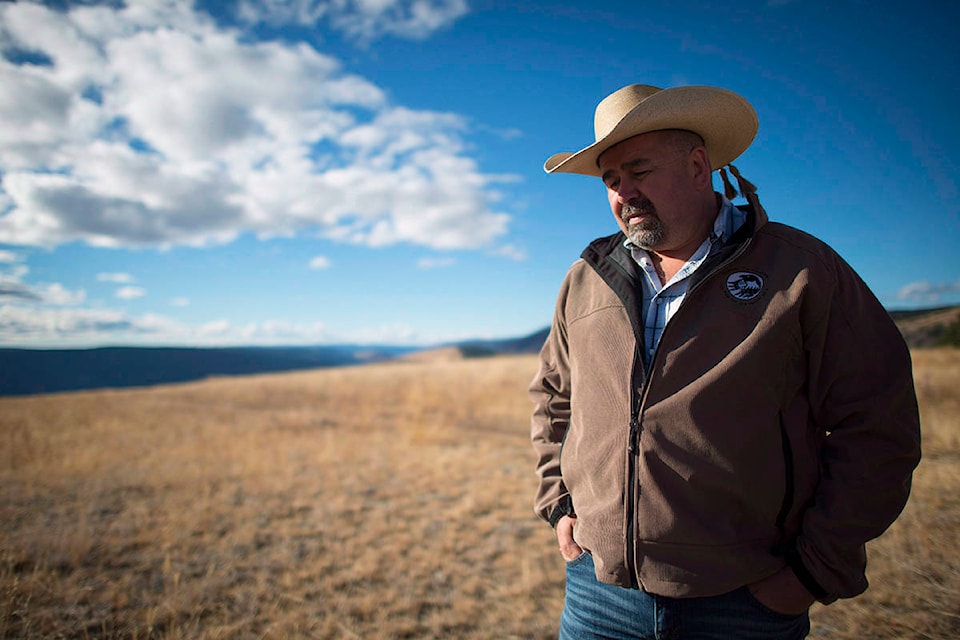High on the Chilcotin plateau in British Columbia’s Interior, the chief of a local First Nation says the traditional diet of its members is threatened by a landslide more than 150 kilometre away.
Tl’etinqox Chief Joe Alphonse, who also represents five other local nations as tribal chairman of the Tsilhqot’in National Government, says Fraser River tributaries once teeming with salmon have shown paltry returns since the Big Bar landslide was discovered in June.
“On a good year, you can run across the river on the backs of sockeye, that’s how thick our rivers are. And bright, bright, bright almost fluorescent orange colour, it’s an awesome sight,” he said.
Alphonse estimated up to 170,000 sockeye returned to local tributaries this year where the annual average is closer to one million.
While the slide occurred in the traditional territory of the High Bar and Stswecem’c Xgat’tem First Nations, the Tsilhqot’in are among another 140 First Nations that the federal government has said could also feel the effects.
Members are concerned Ottawa isn’t doing enough to prevent further damage to stocks, and that the public may not realize there is still a crisis because salmon runs are finished for the season, he said.
READ MORE: First Nations want Big Bar landslide cleared ASAP to allow fish passage
On Nov. 15, the Tsilhqot’in government sent a letter to the office of the fisheries minister requesting an update on the department’s progress, including monitoring and contingency plans should mitigation fail.
The letter asks for immediate updates when work barriers are encountered, in the interest of a “collective and transparent approach.”
Stocks already faced challenges of historic overfishing and habitat loss and the landslide could prove an extirpating blow, Alphonse said.
The possible loss of salmon, combined with a decline in moose populations because of the 2017 wildfires, means wild meats are scarce in region.
“A lot of our people live way under what the Canadian society would consider the poverty line, but a lot of our people are able to do that because they can still obtain a lot of their sustenance through hunting and fishing,” he said.
Fishing also plays an important cultural role in the community, and five months of the local calendar year are named for salmon or trout, Alphonse said.
“It’s huge, huge, huge, the impact on my community,” he said.
The Tsilhqot’in aren’t alone in calling for more action.
On Monday, the Union of B.C. Indian Chiefs issued a media release on behalf of the First Nations Leadership Council asking the federal and provincial governments to declare a state of emergency, and for resources to be prioritized to remove the obstruction within the next 60 days.
It also asks the federal government to identify and fund a working group, including representatives from affected First Nations, to monitor the efforts and develop contingency plans in response to the crisis.
ALSO READ: Threats to the Fraser River at ‘new zenith,’ says river conservationist
No one from the Department of Fisheries and Oceans was immediately available for comment, but it held a media briefing last week updating the progress of federal, provincial and local efforts.
The department said water levels are beginning to drop on the river, presenting the only opportunity to remove enormous amounts of rock blocking salmon migration routes before spring and summer runs arrive.
Officials warned there’s a “high risk” they won’t be successful in rescuing the threatened salmon before the 2020 season.
In a request for information from the private sector that closed on Friday, the federal government said initial estimates show 75,000 cubic metres of material was deposited in the river and most of it is still there. The request sought construction and environmental remediation work to support the break up and removal of rock from the site of the slide during the first available low-water window between December and March.
The documents say several Fraser River salmon species are at risk of extinction, which could result in economic losses throughout B.C. and pose risks to the food security and culture of many Indigenous communities along the river.
— By Amy Smart in Vancouver.
The Canadian Press
Like us on Facebook and follow us on Twitter.
